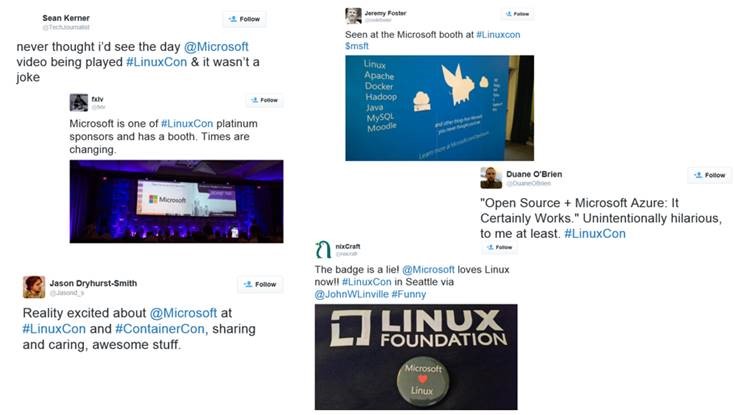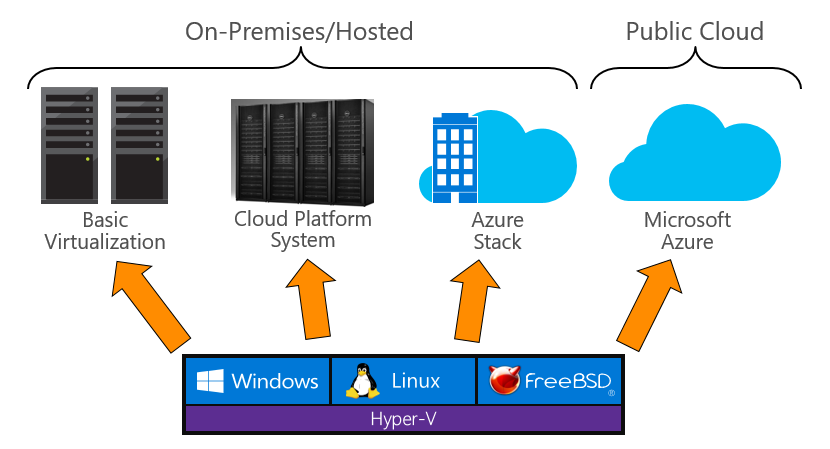Microsoft Loves Linux Deep Dive #12: Summary of Running and Managing Linux and FreeBSD in Your Datacenter
This post was written by Michael Kelley, Principal PM Manager, Cloud + Enterprise
Introduction
This blog post is #12 in a series of technical posts about running and managing Linux and FreeBSD in your on-premises datacenter. Previous posts in the series are here:
Overview
Running Linux and FreeBSD as a guest operating system on Hyper-V
- Microsoft Loves Linux Deep Dive #1: Introduction to Linux and FreeBSD on Hyper-V
- Microsoft Loves Linux Deep Dive #2: Linux and FreeBSD Integration Services Core Features
- Microsoft Loves Linux Deep Dive #3: Linux Dynamic Memory and Live Backup
- Microsoft Loves Linux Deep Dive #4: Linux Network Features and Performance
- Microsoft Loves Linux Deep Dive #5: FreeBSD Overview and Status
Managing Linux and UNIX using System Center and PowerShell DSC
- Microsoft Loves Linux Deep Dive #6: Linux and UNIX Systems Management Overview
- Microsoft Loves Linux Deep Dive #7: Managing Linux in System Center Virtual Machine Manager
- Microsoft Loves Linux Deep Dive #8: Linux and UNIX Monitoring with Operations Manager
- Microsoft Loves Linux Deep Dive #9: Monitoring Open Source Middleware
- Microsoft Loves Linux Deep Dive #10: Managing the Software Configuration on Linux and UNIX Servers
- Microsoft Loves Linux Deep Dive #11: Linux Configuration Management with PowerShell DSC
Microsoft Loves Linux
First, I hope you take away the understanding that Microsoft is committed to Linux and FreeBSD as 1st class guest operating systems in your datacenter. Maybe you’ve seen the “Microsoft ♥ Linux” tagline. But perhaps these recent tweets best capture the sense that Microsoft’s approach to Linux and open source has changed:

Running Linux and FreeBSD
Second, doing a great job of running Linux and FreeBSD as guest operating systems on Hyper-V is fundamental. We’ve heard your feedback as customers that your datacenters are heterogeneous. You run workloads on Windows, you run workloads on Linux, and you probably run some workloads on UNIX. Being able to run Linux and FreeBSD as a guest on Hyper-V enables you to operate a single infrastructure for both workloads, and not have to bifurcate the underlying hardware, the hypervisor, and the management infrastructure. The first few posts in this series describe how Microsoft works with the Linux and FreeBSD communities to build the drivers for running these operating systems on Hyper-V. The posts also describe how high I/O performance is achieved in a virtual environment, and the sophisticated management features, such as online backup and dynamic memory, that accrue to Linux and FreeBSD guests running on Hyper-V.
The capability to run Linux and FreeBSD as guest operating systems on Hyper-V underlies all the different ways you may be organizing your on-premises datacenter. Maybe you are doing straight virtualization in order to consolidate on less hardware and drive up utilization. Maybe you are going a step further and operate a true private cloud based on Hyper-V, System Center Virtual Machine Manager, and Windows Azure Pack. Or maybe you are using the Microsoft Cloud Platform System (CPS), which is an integrated system, combining hardware and software into a private cloud offering that is pre-assembled, pre-installed, and fully tested end-to-end. Finally, as we move into calendar year 2016, the Microsoft Azure Stack offering will provide a fully Azure-compatible private cloud that you can run in your datacenter. In all of these cases, Linux and FreeBSD run as guest operating systems with Hyper-V as the base hypervisor. Of course, the same is true for the Azure public cloud as well.

Managing Linux and UNIX
Third, managing Linux and UNIX is equally key. Regardless of the environment in which you are operating your Linux and UNIX workloads, Microsoft products can provide the OS and workload management, just like with Windows. You can get a single view across your entire datacenter, even if you are running on physical hardware or a hypervisor other than Hyper-V. Our customers have been using System Center to manage their Linux and UNIX servers since 2009, and today several hundred thousand such servers are under management with System Center in production environments.
System Center Operations Manager (OpsMgr) provides day-to-day monitoring of the Linux operating system as well as several different Java application servers. New for OpsMgr in the upcoming 2016 release is monitoring of key open source middleware components such as the Apache web server and the MySQL and MariaDB databases, running on Linux. OpsMgr monitoring can also be easily extended to cover your specific application and workload needs via custom shell command lines or other scripts running on Linux. System Center Configuration Manager (ConfigMgr) provides hardware inventory and installed software inventory across all of your Linux instances, and provides software distribution, enabling you to push out new software packages to large groups of Linux servers based on criteria you control. OpsMgr and ConfigMgr also go beyond just Windows and Linux, providing the same capabilities for major UNIX operating systems.
PowerShell DSC for Linux and Microsoft Operations Management Suite (OMS) are the two newest management products to offer Linux capabilities. PowerShell DSC for Linux gives you a consistent set of tools to define the state of Windows and Linux operating systems, and to detect and remediate configuration drift. You’ll see additional announcements in this area in the coming months as we continue to do new development work. Similarly, OMS is one of an increasing set of hybrid offerings that span the public cloud and on-premises operations by offering management of on-premises servers from the cloud. No on-premises infrastructure is needed. OMS Log Analytics features are now available for Linux in public preview, enabling collection, analysis, and visualization of performance metrics and syslog data. The OMS Automation Solution enables runbook-based automation for your Windows and Linux environment as well as configuration management with Desired State Configuration. You can expect the functionality offered will grow rapidly in the coming months.
Hybrid: Azure and On-Premises
Finally, while this blog post series has focused on capabilities for your on-premises datacenter, heterogeneity is equally important in the Azure public cloud. Indeed, more than 25% of the customer VMs in Azure are running Linux, and that percentage is growing. A range of services, including IaaS virtual machines, HDInsight (hadoop), and the Azure Container Service are available today in Azure running Linux. Plus, a huge set of open source tools and services are available to you running in the Azure public cloud. As your organization considers putting workloads in the public cloud while retaining an on-premises datacenter footprint, the Microsoft hybrid story is unique in its ability to integrate the two worlds and give you flexibility to move between them as suits your business purposes. Running and managing Linux and FreeBSD in both worlds is a fundamental part of that hybrid story.
Wrap-Up
While this series wraps-up with this post, in 2016 we’ll have additional technical posts about running and managing Linux and UNIX in your datacenter. For example, a multi-part series on setting up and running Linux operating system clusters using shared VHDX files in a Hyper-V cluster is planned to start in January. Thanks for reading!